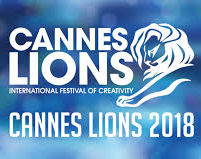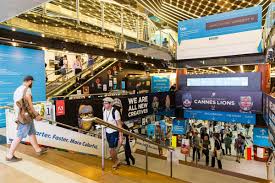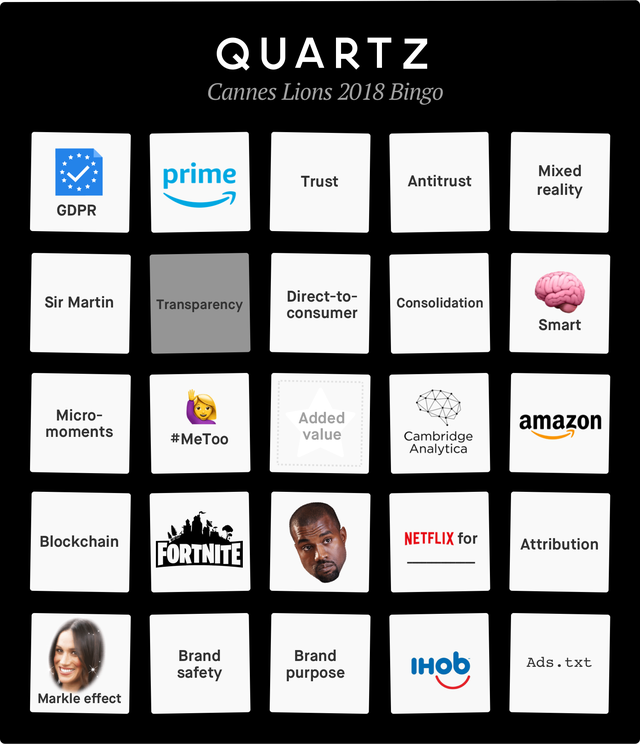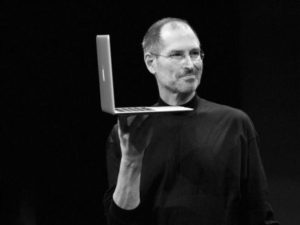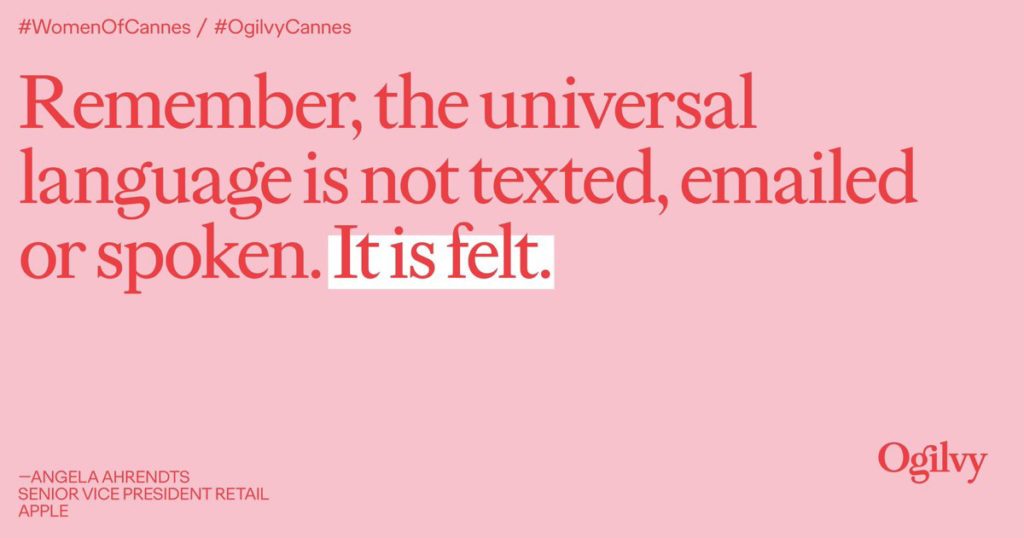(with a heartfelt thanks to staffers Catarina Conti and Silvia Di Prospero)
19 June 2018 (Cannes, France) – And we are here, Day 2, of our annual visit to the Cannes advertising conference. Or to give it its full honorific, the Cannes Lions International Festival of Creativity 2018.
…or what I like to call, “The Conference of the World’s Attention Merchants”. Because over the last decade, the festival has evolved to include not only more brand clients but also, as media fragmentation has forced the change of some and the birth of others, an expansion in tech companies, social media platforms, consultancies, entertainment and media companies — essentially the entire attention ecosystem.
And politics is everywhere. Given the current political climate, gun control and Trump are hot topics. Also, the #MeToo and #TimesUp movements, which have impacted so many agencies at the leadership level this year. In the last six months, the industry has undergone a major transformation.
SOME BACKGROUND
Cannes Lions is a global event for those working in the creative communications, advertising and related fields. It is considered the largest gathering of worldwide advertising professionals, designers, digital innovators and marketers. The Lion awards are also the most coveted and well respected in the entire advertising and creative communications industry. The event, held every June, runs five days this year (down from eight days).
NOTE: There was a feeling that Cannes had “lost the plot” with its extravagant partying, high spending and sprawl. So this year, Cannes is a bit smaller and more toned down, part of a long overdue “streamline and focus” initiative by the organizers. And no free tee-shirts this year (Sad!)
It is actually the smallest “major” event our team attends/covers (LegalTech is the smallest). This year Cannes Lions has 18,500 registered delegates from 118 countries. There is content from over 500 speakers and more than 32,000 pieces of work to see.
The event was inspired by the Cannes Film Festival, staged in Cannes since the late 1940s, when a group of cinema screen advertising contractors belonging to the Screen Advertising World Association (SAWA) felt the makers of advertising films should be similarly recognised. It launched in Venice, Italy, in September 1954, with 187 film entries from 14 countries. The lion of the Piazza San Marco in Venice was the inspiration for the Lion trophy. The event then alternated between Venice and Cannes before settling in the latter in 1984. New categories have been created for awards in recent years to reflect creative effectiveness.
The event attracts everybody. This year the folks who make ads for baby food, incontinence aids and cans of beans get to rub shoulders with the likes of Halle Berry, Halsey, Ron Howard, Helen Mirren, Ian McKellen, Gwyneth Paltrow, Brad Pitt, and Meryl Streep.
NOTE: Our visit is significantly subsidized by my long-time advertising client (who remains unnamed so that I can write my impassioned, curmudgeonly commentary) who arranges for us to attend several of the VIP events.
And the best app at any conference I attend: the Cannes Lions “Networking App” which uses a funky artificial intelligence to help you meet the right people efficiently and easily. Brilliant app.
Just a few short notes now with a longer post after the conference:
THE BUZZWORDS AND OPENING KEYNOTES
Jargon and buzzwords and slang. OH, MY! The team from Quartz got us off to a good start over the weekend (lots of Sunday pre-event activities were on deck):
Although antitrust is up there (natch), “AT&T/TIME WARNER” deserves special mention and I will have a detailed note over the weekend, because only two days in and we’ve engaged in or stumbled across multiple conversations about “that” court case from last week.
David Droga set us up with an opening keynote entitled “I’m Not Sure I’m Right but Who is?”. David, as I have noted before, is an advertising wiz. He founded his own agency, Droga5, in 2006 and has received all the top industry awards from Advertising Age, Adweek, and, here, at Cannes Lions. His agency was ranked Number 1 in Fast Company‘s top ten advertising and marketing companies in 2017.
In his keynote he noted:
As creatives and marketers, we are problem solvers working to make a positive impact on a business and, in some cases, the world. Creativity has proven to be at the root of some of the most intricate and difficult dimensions in our world, from social justice movements and tech innovations to health advancements and infrastructure strengthening
But recently, the “easy things” – such as unity, ambition, loyalty, empathy and even common sense – have been “engineered out” of too many corporations and leadership circles.
What followed shortly thereafter was the Deloitte Digital/Amazon panel on “Creativity” which got the juices flowing. In 2018, 50% of the fastest-growing companies in the world will “employ” more smart machines than people. But while AI tools were once a “nice-to-have,” with improved accessibility, AI is no longer a real competitive advantage, but rather a business necessity across industries. This was a riveting session on how companies, hungry to regain the advantage once offered by AI, must embrace a digital transformation and use these tools to drive creative business solutions and build creative teams.
THE PLATFORM BACKLASH
Just a few years ago, Facebook and Google were the toast of the town. Google has long used Cannes to butter up creatives (and media buyers and marketers), and Facebook has grown its presence alongside Google.
This year, both are taking a beating as more calls come to break up the duopoly’s power – and Facebook gets grief over its data scandals and role in electing Donald Trump. The days of connecting the world as an aspirational dream have hit the hard reality of the use of the platforms to divide people, while the platforms themselves have run roughshod over entire industries to their own benefit. Already I’ve seen newly emboldened publishing executives like The New York Times CEO Mark Thompson continue beating up Facebook and, to a lesser extent, Google.
ARTIFICIAL INTELLIGENCE
Just a few snips because machine learning and AI are huge themes here and have hit many sessions.
Among various keynote speeches and discussions that ensued during the opening day on Monday, “Accelerating Creativity in the Age of AI” has to be one of the best. It brought together the likes of Adobe’s Vice President of Design, Jamie Myrold, artist Mario Klingemann and Pentagram partner Natasha Jen who kicked off an intriguing discussion about all the ways the rise of artificial intelligence can actually aid in the creative process. The session delved into various aspects like how artificial intelligence will impact creativity and the human aspect of the creative process. Said Jen to kick it off:
Machine learning is very much integrated into our lives in so many ways that we don’t even know it. Deep-learning has begun to emerge as the next wave. AI is further going to increase efficiency remarkably, and productivity is also going to increase. We will be able to materialize our ideas much faster.
Klingemann opined that we can reap the benefits of machine-learning in an efficient manner, that today we have more and more data which is like a wealth. We can utilize machine-learning to pull out things and get truth out of the data. But he said:
I fear sometimes that we’re not as creative as we think. We need to have impulses coming out that trigger something in us. With machine learning, we can have the machine give us these impulses based on what it thinks might be relevant to us and then augment it. With these we can almost goldmine the past, add something new to them and give it a new twist.
Myrold also shed light on the role of creative AI: does it have the potential of democratizing creativity? She said:
Democratization of tools is already happening. You have access to creative tools like Instagram and Facebook without even knowing that it is assisted by AI.
Jen contended that the language around new technology is always so nuanced that you have to look at the historical trajectory as well as the contemporary landscape.
An interesting point of discussion was also around the authorship of the creative work: who does it lie with? Is it human beings or the tools? Both Jen and Klingemann feel that while tools are there, it’s still humans making the decisions. Jen pointed out that over time we will see more and more augmented reality (AR) functions available, which will go beyond the putting a filter on your face. But the panel was agreed: a lot more really practical AR applications are on the way. Discovering of that knowledge will be really exciting.
GDPR
The arrival of the General Data Protection Regulation has led some U.S. vendors like Verve and Drawbridge to pull out of Europe entirely to avoid the cost of getting their businesses GDPR-compliant, and avoid any risks should they fail to do so. Most ad tech executives are pretty candid in their predictions that other noncompliant U.S. vendors will also be forced to leave Europe in the coming months. And many vendors have unveiled their “two sites” approach: one for U.S. consumers, and the other for rest of the world.
GDPR has already dominated a lot of my conversations … though easier to handle with free-flowing rosé on hand to soften some of the gnarlier questions. Publishers that have felt at a disadvantage as a direct result of Google’s last-minute GDPR policy changes plan to continue their conversations with the tech giant at Cannes, behind closed doors, according to sources. Meanwhile, advertisers will also ask difficult GDPR-related questions of vendors about how they can ensure they’re passing consent on verified audiences and inventory. Best quote by Ben Barokas, founder and CEO of ad tech vendor, Sourcepoint:
Look, it’s going to be an iterative process, and this GDPR compliance stuff will be a marathon and a theme far into the future. There will be many, many, many lessons learned.
And with two e-discovery vendors here, plus a GDPR subject matter expert (an attorney) … none presenting, merely attending … some of the conversations have been easier. At a panel discussion about concierge marketing – the idea of servicing and personalizing marketing – a rep from Nestlé spoke about how user reviews are proving to be a good source of first-party data to get around GDPR concerns. Under GDPR, companies that collect third-party data are required to revamp their processes for collecting personal information, and consumers are allowed to opt-out. As brands have ramped up their prep for GDPR, marketers are increasingly focusing on first-party data practices that ask consumers to explicitly fork over their own information – think email signups, mobile app downloads and comments.
But marketers have noted they are looking to move away from their reliance on third-party data. And these points are important for my e-discovery readers who are helping their clients with GDPR issues.
NOTE: What is third-party data? Every business uses some form of customer data, mostly first-party, which means that the company has collected and stored the data itself. This data is used to manage current customers. But when companies want to find new customers, they use third-party cookies to target and retarget prospective customers across multiple touch points – a practice that some marketers here say is already dying.
In advertising/marketing that’s a biggie. As I noted in a longer post during our Cannes Lions coverage last year, the idea of third-party data basically pulls from two areas. First, there is the original reason third-party data became important to marketers, which is that they wanted to buy categories of potential buyers based on socioeconomic status, age, income, etc.; in other words, third-party data became important for data append use cases. The second reason third-party data became important was because ad systems became dependent on it. Their business model relies on cookie sharing across the board.
And I have seen a shift in brands. I am starting to see brands turn away from third-party data as consumer concerns for data privacy rise. I expect to see that shift continue as companies are forced to rethink their engagement channels and begin to look toward direct engagement tools to reach their customers. And the reason it is a “biggie”, as I noted above, is because the third-party data ecosystem is in danger. I think we can expect to see smaller ad-tech companies that depend on third-party data go out of business as they struggle to keep up with policy changes or be forced to make major changes to their core business model. The demise of these smaller companies and third-party ad networks will further elevate the Facebook/Google duopoly within the ad ecosystem. It just has to happen … not quite what the EU Commission had in mind – making Facebook and Google stronger. GDPR has become the bogeyman in the real data world, not quite understood in the cloistered hallways of Brussels.
Yes, there will always be a role for third-party data. But due to the GDPR, recent Facebook scandals, and the general climate around customer data privacy, ownership, and control, brands are looking for alternatives to cookie sharing, and they’re looking to first-party data to perhaps become this alternative.
I’ll have a much longer post on this issue after this festival.
STORYTELLING
This graphic always gets a lot of play at the Festival:
“The most powerful person in the world is the storyteller” – Steve Jobs
This Festival has become my favorite event because it is where I have learned the most about the impact of technology, the visualization of data, creativity, and how to create a high level of quality storytelling. Given this post is running waaaaaaay too long, I will reserve the “storytelling” piece for my Festival wrap-up.
TODAY’S “MOMENT OF ZEN”: BRANDS ARE STARTING TO VISUALLY DISAPPEAR,
SONIC BRANDING IS THE FUTURE
There was a panel of industry experts in audio that spoke about how voice will change the world. All the statistics claim how huge voice is going to be, but is that really what the industry is experiencing? One in six U.S. households have voice assistants, so it’s coming hard and fast. As advertising agencies (and fans), you need to think about this and how to put your brands forward in this new space. McCann London’s managing director Sheryl Marjoram said we all have a voice and that companies and brands shouldn’t exclude the older generation: “Voice doesn’t care if you’re six or 106”.
And this isn’t going to have an adoption rate like tech. There isn’t going to be the normal awkward start were people get anxious or intimidated, it’s not going to exclude and will welcome in everybody. A third of the people who have smartphones are 55 and over. It’s not just for the kids. However, brands are starting to visually disappear, and many on the panel believes that a “sonic identifier” will really help brands to continue to capture to customer experience. There are so many technologies now that are voice first, voice only or sound. If brands don’t have an identifier, if they don’t have a way to carry people through those customer experiences, then they are not going to get credit for those things. The engagement levels go up when you use sound in terms of the customer experiences.
And voice offers brands a sweet spot. Voice is an opportunity for brands to get in there and figure out what gift they are going to give the world, how are they going to turn up and what can they do that is really different to give real meaning to customer service. Brands can really express themselves with sonic branding. The power of the emotion voice can offer from the music or feeling or sound. Said Marjoram:
It’s a really powerful sense, and we should really be using that when we think about brand marketing. The problem is talking is very disruptive and most people who are approaching voice, are approaching it the wrong way. You can’t just think about the human voice. You need to score the customer experience, not only for the brands to get credit, but for these experiences to be really next level intuitive that you clearly know emotionally what the customer wants.
